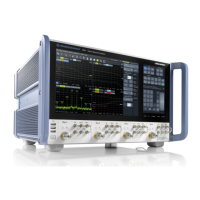Concepts and features
R&S
®
ZNA
255User Manual 1178.6462.02 ─ 20
To this end, the RF output power is measured on a "leveling grid", i.e. at equidistant RF
input power levels P
RF-In, i
and frequencies f
j
. Two-dimensional interpolation is then
used to obtain the appropriate input level for the desired output level at a given fre-
quency. Selecting smaller step sizes can improve the interpolation accuracy, at the cost
of an increased leveling duration.
Frequency converter leveling can be performed via the standard Power Cal wizard. For
each frequency converter port, the leveling procedure consists of the following steps:
1. Source flatness calibration (optional)
To improve the accuracy of P
RF-In
, it is recommended to perform complementary
source flatness calibrations at the related analyzer ports (including the cables con-
necting the analyzer port to the RF Input of the frequency converter).
2. Reference receiver calibration
During this step, connect a power meter to the test port of the respective frequency
converter. The calibration consists of a single frequency sweep f
1
, ..., f
n
during
which P
RF-Out
(f
j
) and P
REF
(f
j
) are recorded, where P
REF
(f
j
) denotes the power mea-
sured by the VNA reference receiver.
Optional extensions and accessories

